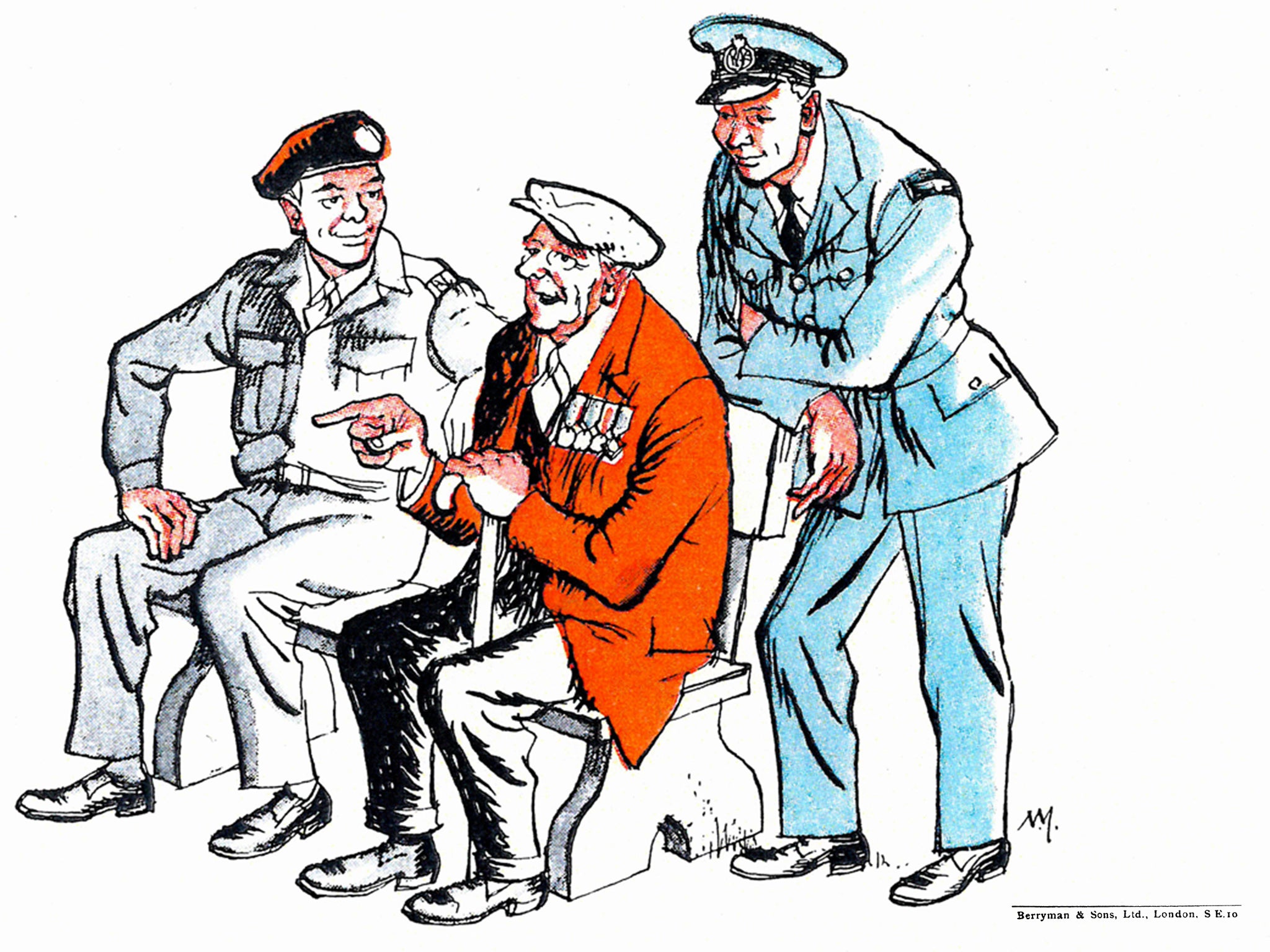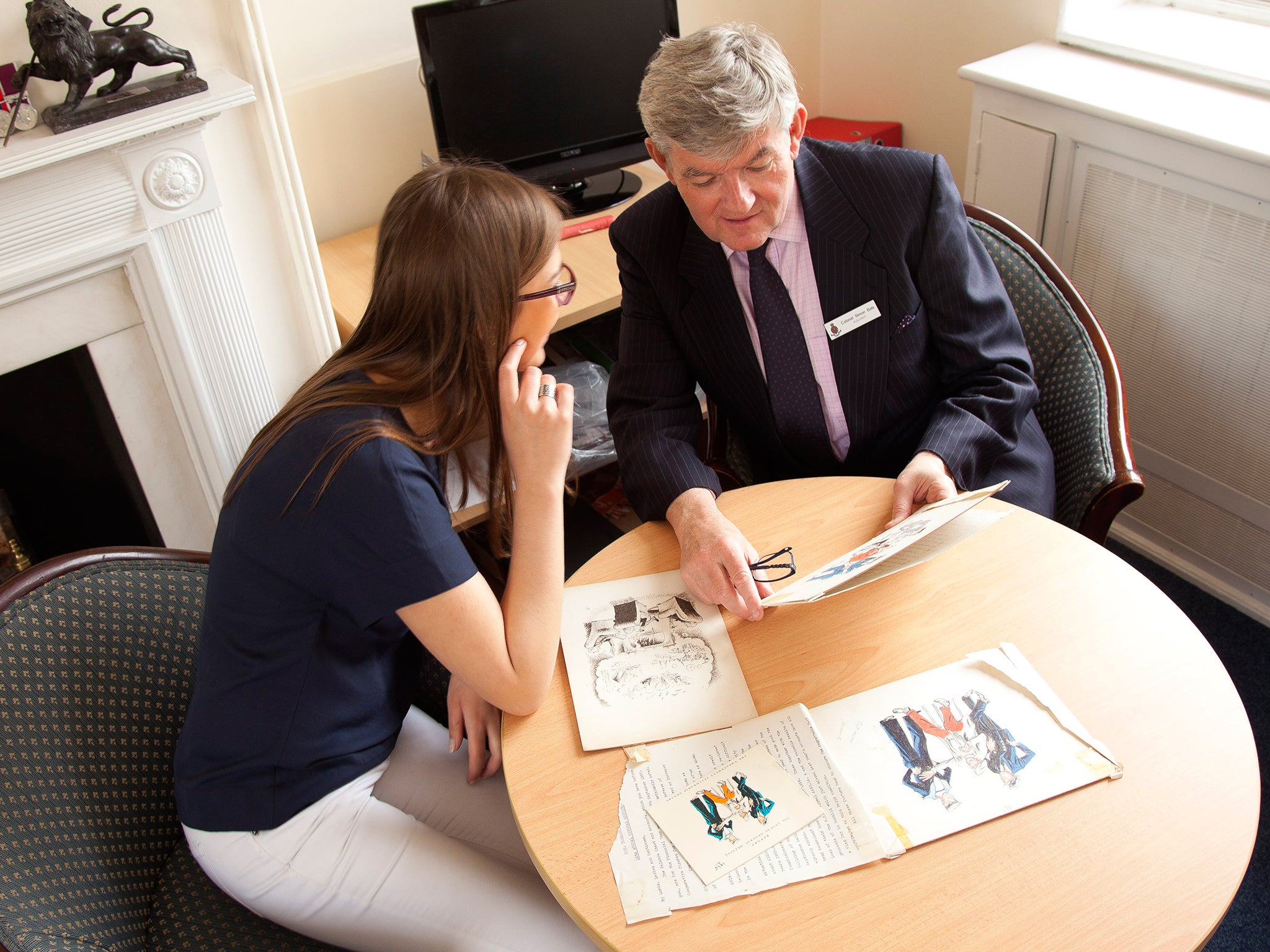War artist's cartoon resurrected by veterans charity in WW1 centenary year
It is from original drawn by Norman Mansbridge for the Ex-Services Fellowship Centre (later Veterans Aid)

It’s an image that bridges generations – in terms of content and activity. Two young servicemen chat to an older veteran whose row of medals and stabbing finger indicate the telling of an old warrior’s tale.
Today, the 82-year-old charity Veterans Aid, to whom the cartoon was presented by the artist, plays a similar role in connecting younger veterans who seek its help, to In-Pensioners at the Royal Hospital Chelsea. A formal outreach programme that benefits both organisations, it echoes the tradition of ‘veteran helping veteran’ that illustrator Norman Mansbridge found reflected in the charity so many years ago.
Like many other fragile and yellowing documents in Veterans Aid’s Victoria archive it harks back to a time when life was considered simpler, but the problems affecting ex-servicemen no less complex than they are today. The charity was born in the aftermath of WW1 when men with nowhere else to sleep bedded down on London’s Thames Embankment. Then, as now, they were helped to get back on their feet and given the tools to deal with the consequences of unemployment, poverty, family breakdown and ill-health.
VA’s decision to resurrect one of the drawings presented to it by Mansbridge, as the cover of its 2014 WW1 Centenary Annual Review, resulted in much more than a trip down Memory Lane.
It led, indirectly, to finding the grand-daughter of its founder - Mrs Gwendolyn Huggins - and the discovery of other original sketches and cartoons by the man whose distinctive ‘M’ signature was as famous in its day as those of ‘Giles’, ‘Scarfe’ and Matt’ came to be.

Further researches into the Mansbridge relationship also turned up a much older link between Veterans Aid and the Royal Hospital Chelsea. While his wife was fighting to establish the Ex-Services Fellowship Centre, Major Gilbert Huggins was unknowingly forging the first links between EFC and the RHC. In 1932 he became its 20th Adjutant, a post he held for five years, and VA archives record the fact that, at the end of his tenure in 1935, he presented EFC with a billiard table.
The current Adjutant, Colonel Simon Bate, had no idea that VA’s founder had once occupied his seat. “But when I heard this I thought that it was fascinating that the two charities and organisations were so linked and how good it is that we have come together again, as we have, mutually supporting each other”.
Reflecting on what the role might have involved in 1932 he said, ”Originally an Adjutant used to be Staff Officer to the CO, as I was when I was 24, responsible amongst other matters for the discipline in the Regiment . . . here, today, it’s much more of a personnel role here, and is better understood as the Director of Welfare.”
Indicating the board on his office wall Simon explains how the ranks of RHC’s various Adjutants crept up from Ensign (presumably in 1692 when it opened) to Brigadier in 1952. The name of one distinguished post-holder, Lt-Col W.M Mackay, is followed by the post nominals DSO, MBE and MC.
The RHC today has four outreach programmes that keep its residents in touch with veterans less fortunate than themselves; Kensington Night Shelter, HMPs Wandsworth & Wormwood Scrubs. Tedworth House – and Veterans Aid. “We looked for projects that we could sustain and although we don’t see VA clients every day of the week the contact is regular. The In-pensioners get so much satisfaction from their visits to the hostel. It gives them a sense of purpose and is also a way of giving something back. The bowls matches between our two organisations have been a great success.”
Homeless Veterans:
Donate now: Quick online way to make a difference
Full links: The Who, What and Why of our appeal
Bid now: Part 2 of our charity Auction
Seeing VA’s original Mansbridge cartoons for the first time Simon observed how well they captured the interaction of generations that is so much part of the VA/RHC interaction today.
Norman Mansbridge was born on 22 July 1911 in Wanstead, Essex. He went to Forest School, in Snaresbrook, Essex, and studied art at Heatherley's in London.
His career as freelance cartoonist was interrupted by war. In 1939 Mansbridge served in the Auxiliary Fire Service, but in 1940 joined the Merchant Navy; ostensibly as a wireless operator with a roving commission as a war artist.
After demob, in 1945, Mansbridge returned to London to work for titles such as the News Chronicle, Men Only, The Sunday Times, Radio Times, Lilliput, Daily Sketch and Birmingham Post.
Ten years later he became the only cartoonist ever to have eight colour pages in a single issue of Punch, with the publication of "The Pursuit of Happiness," a moral tale about life in Britain, similar to Hogarth's "Marriage A la Mode."
By 1958 he had been elected to the Punch Table, and became the magazine's political cartoonist, despite allegedly saying that he had no interest in politics.
Andre Gailani, from Punch, said, “ Norman Mansbridge's first cartoon published in Punch was in 1937 after having worked as an apprentice in a commercial art studio for advertising. He served in the AFS and Navy during WW2 and in the 1950s complemented his social/gag cartoons with political cartoons, at first sharing these duties with EH Shepard and Leslie Illingworth and then taking over in the 1960s. ”
By 1958 Mansbridge had been elected to the Punch Table and became the magazine's political cartoonist . . . despite allegedly saying that he had no interest in politics.
Gailani added “He illustrated eight colour plates in one issue for the Pursuit of Happiness, the only cartoonist to achieve this, and illustrated books for Basil Boothroyd and Malcolm Muggeridge. He was a founder member of the British Cartoonist's Association in 1966 and worked in pencil first, then completing his cartoons with fountain pen and black ink. He also painted and exhibited oils at the Royal Academy, taught art and illustrated adverts. His final cartoon in Punch was in 1985. ”
It wasn’t until the 1960s that the cartoonist and the charity crossed paths - at a time when the former was definitely a household name. The earliest known copy of an Annual Report featuring Mansbridge’s work is 1964 – a modest postcard-sized leaflet with his illustrations on the front and back covers.
CEO of Veterans Aid Dr Hugh Milroy, who approved use of the illustration 50 years later, said, “In going through the archives we were all struck by how, after all this time, it still captures the spirit of this charity. We had no idea that Mansbridge had been so famous or how he came to present us these images.
Homeless Veterans:
Donate now: Quick online way to make a difference
Full links: The Who, What and Why of our appeal
Bid now: Part 2 of our charity Auction
“We’ve been involved with some quite famous names over the years; actors Ralph Richardson and Flora Robson starred in our first film, Smith, which was denied its parliamentary premier because of the war. It was once described as iconic director Michael Powell’s ‘lost film’ until it turned up in a dusty drawer. We’ve also unearthed photographs of actress Dame Cicely Courtneidge tasting soup in an EFC kitchen, discovered that a broadcast appeal for funding was made by Dame Anna Neagle, and that royals were regularly welcomed at our Centre. Finding out that a famous cartoonist did a cover design for us is just one more in a string of happy surprises.”
Mansbridge worked first in pencil and then with a fountain pen and black ink, preferring to memorize a subject rather than draw it on the spot. The Veterans Aid archive contains sketches that are clearly rough first drafts of the three servicemen – later outlined in ink with instructions for later use of colour.
As 2014 draws to a close, In Pensioners from the Royal Hospital prepare to make their last visit of the year to VA’s New Belvedere House (* Wednesday 17th December) - 82 years after the relationship between the two charities began.
*Norman Mansbridge died in 1993 at the age of 82.

Join our commenting forum
Join thought-provoking conversations, follow other Independent readers and see their replies